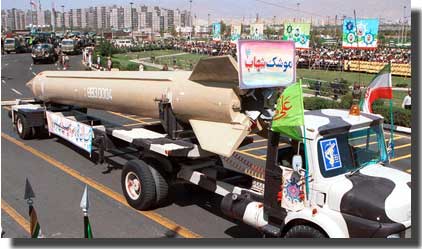
After Iran:
Keeping Nuclear Energy Peaceful
Henry D. Sokolski
![]()
|
The best chance for nations seeking to prevent further nuclear proliferation is to enforce the original presumption of the Nuclear Non-Proliferation Treaty's Article IV, says author Henry Sokolski. Article IV presumes "against the unnecessary spread of unsafeguardable nuclear activities and materials." In the case of Iran, Sokolski writes that "Tehran's operation of an enrichment plant ?should be regarded as being neither peaceful nor protected under Article IV of the NPT."
Sokolski is executive director of the Nonproliferation Policy Education Center, a nonprofit educational organization in Washington, and is editor with Patrick Clawson of Getting Ready for a Nuclear-ready Iran (U.S. Army War College, Spring 2005).
Iran's claim that it has a "peaceful" right to acquire all it needs to come within days of having a bomb should remind us of what the Nuclear Non-Proliferation Treaty (NPT) was meant to avoid. As the diplomat who first proposed the treaty, Irish Foreign Minister Fred Aiken, explained in 1959, a world of nuclear-ready states would resemble a town full of armed residents pointing guns at each other's heads. At some point, mutual suspicion and the advantage of firing first would give way to mayhem.
This was what the NPT was supposed to prevent. In l965, the United Nations General Assembly resolved that the NPT was to be "void of loopholes which might permit nuclear or non-nuclear power to proliferate, directly or indirectly, nuclear weapons in any form." As a result, the treaty's negotiators rejected proposals by Mexico and Spain to make the nuclear-weapon states' sharing of "the entire technology of reactors and fuels," including the means to produce nuclear weapons-usable materials, a "duty" under the NPT.
The treaty's negotiators understood that although nations should be free to develop "peaceful" nuclear energy under the NPT, whether or not a particular activity met this criterion depended upon a number of factors. First, could the activity in question be safeguarded, as the NPT required, to prevent it from being diverted "from peaceful uses to nuclear weapons?" Could the NPT's nuclear watchdog, the International Atomic Energy Agency (IAEA), monitor it in a manner that could reliably detect the loss or theft of enough nuclear material to make a bomb before this material could actually be fabricated into an explosive?
Meeting this timely detection criteria, which the IAEA has adopted to define its safeguard procedures, is still untenable at nuclear facilities that handle or can quickly produce large amounts of nuclear weapons-usable fuel. Such industrial units include plutonium separation plants, uranium-enrichment facilities, and factories that fabricate highly enriched uranium (HEU) and plutonium-based fuels.
Missing in Japan, Britain
Why are inspections at such plants insufficient to safeguard against such diversions? Consider Japan's recent experience. In January of 2003, Japanese officials admitted that their pilot plutonium reprocessing plant at Tokai-mura "lost" 206 kilograms of weapons-usable plutonium (roughly 40 crude bombs' worth) over the previous 15 years. The Japanese hadn't diverted the material; they simply were at loss as to where this material might have gone. One popular theory is that the material was "stuck in the pipes;" another theory is that it remains dissolved in chemical solution. These reported losses were in addition to the 70 kilograms of plutonium Japan previously conceded remained unaccounted for at a plutonium-based fuel fabrication plant it was operating. The British, meanwhile, have experienced similar losses at their plutonium reprocessing plant at Sellafield. There, 19 kilograms of separated plutonium went missing in 2003 and another 30 kilograms of separated plutonium went unaccounted for in 2004.
All of these plants operated under the watchful eye of the IAEA. This highlights two major safeguards deficiencies. First, with the unaccounted amounts of weapons-usable plutonium each year being many times what is needed to make a bomb, there is no way to be sure this material might not have already been diverted. Second, any nation operating such plants could at any time take any of the nuclear material they had produced (both accounted for and unaccounted for) and convert it into bombs well before any inspector or outside authority could step in to block the diversion.
With commercial uranium-enrichment facilities and highly enriched uranium fuel fabrication plants, which process tons of enriched uranium annually, equally hair-raising material loss scenarios are possible. For example, IAEA inspectors still cannot independently verify the production capacity of any given centrifuge-enrichment plant. As such, an enrichment plant operator could "lowball" his facility's capacity to IAEA inspectors and, in between IAEA inspections, covertly produce and divert enriched uranium for military purposes without being detected. Such diversions, moreover, could take place without IAEA inspectors necessarily being tipped off.
Also (as with plutonium bulk-handling facilities), there is the problem of how quickly a non-nuclear weapons state could break out of its NPT obligations and make bombs with these plants. All of the facilities mentioned process materials that could be converted into bombs in days or weeks—well before any outside authority could intervene even if the diversion was detected.
With these activities, unless there is a compelling economic need to proceed, then, there are obvious security imperatives for holding back. Clearly falling into this category are the reprocessing of plutonium, the fabrication of plutonium and HEU-based fuels, and the production of HEU. All of these nuclear activities generate or handle nuclear weapons-usable materials, are not essential to having civilian nuclear power, and, in most cases, are sure-fire money losers.
A Surplus of Enrichment Capacity
As for lightly enriching natural uranium to contain 3-to-5 percent uranium-235, this is required to fuel the world's light water reactors. What's unnecessary, however, is to expand the current surplus of enrichment capacity, which is more than able to supply world demand for at least the next 10-to-15 years. Given that it takes no more than five years to build substantial additional enrichment capacity, the time for any nation to build or invest in creating more net capacity is still at least 5-to-10 years away. That and concerns about the spread of this technology are why both President George W. Bush and IAEA Director-General Mohamed ElBaradei have proposed restricting the construction of new enrichment plants.
Certainly, there is no economic justification for nuclear novices like Iran to enrich uranium. Tehran only has one nuclear power station that requires lightly enriched uranium fuel, and Russia has promised to supply Iran with all the enriched uranium it needs for the entire lifetime of the reactor. Separate from the matter of Iran's trustworthiness (even after two years of intensive investigations, the IAEA has not yet been able to say whether Tehran is in the bomb-making business), Tehran's operation of an enrichment plant is neither safeguardable nor economically defensible. As such, this undertaking should be regarded as being neither peaceful nor protected under Article IV of the NPT.
Again, if Iran had a legal right to acquire such unnecessary, unsafeguardable nuclear facilities, what would keep Tehran's neighbors from following suit and becoming nuclear-weapons-ready as well? Indeed, what would prevent the world ElBaradei has repeatedly warned against from emerging: one with 20 or more states only days or weeks from a bomb, all primed to believe their nuclear capabilities might keep them safe? We know where the military build-up and mutual suspicions of 1914 led—to World Wars I and II, with over 100 million dead. Imagine a similar powder keg—only this time with nuclear-armed contestants stretching from Beijing to Washington and Algeria to Japan.
Back to NPT Basics
If we wish to avoid the worst, we should back the NPT's original presumption in Article IV against the unnecessary spread of unsafeguardable nuclear activities and materials. In specific, states before, at, and after the NPT Review Conference should consider proposals to put the original view of Article IV into play for nuclear supplier- and nuclear recipient-states alike and, to the extent possible, for non-members of the NPT as well.
Among the steps that ought to be considered are:
- An indefinite freeze on any expansion anywhere of existing plutonium separation efforts, and of fuel fabrication plants that handle nuclear weapons-usable fuels, until methods can be devised to provide appropriate, timely detection and warning of diversions from these plants.
- A five-year, renewable moratorium on the expansion of any nation's net uranium enrichment capacity. Under this proposal, states could modernize existing capacity, but whatever new capacity they put up would have to be balanced by bringing down an equivalent amount of old capacity.
- A call for all states to compare openly any proposal to build or complete a large nuclear facility against alternatives that could produce similar benefits at less cost. Here the U.S. could best take the lead by upholding title V of the U.S. Nuclear Nonproliferation Act of 1978. Under this law, the U.S. is "to cooperate with other nations, international institutions, and private organizations in establishing programs to assist in the development of non-nuclear energy resources." To date, key provisions of this law have not been implemented.
- An indefinite suspension of international transfers of nuclear weapons-usable materials, i.e., of highly enriched uranium or separated plutonium, unless the transfer's purpose is to dispose of the material or to make it less accessible for weapons use.
- A reassessment of the limitations of the IAEA's ability to safeguard the nuclear facilities and materials it monitors.
In each case, the NPT Review Conference could evaluate the merits of instituting or of extending each of these proposals every five years. This would give the NPT Review Conference important operational issues to focus on. More importantly, adopting one or more of these proposals would go a long way to making Article IV and "peaceful" nuclear power meaningful, i.e., to achieving the NPT's ultimate purpose. The alternative is to wait not only for more Irans, but the clear undoing of the NPT.
![]()
The opinions expressed in this article do not necessarily reflect the views or policies of the U.S. government.
![]()
